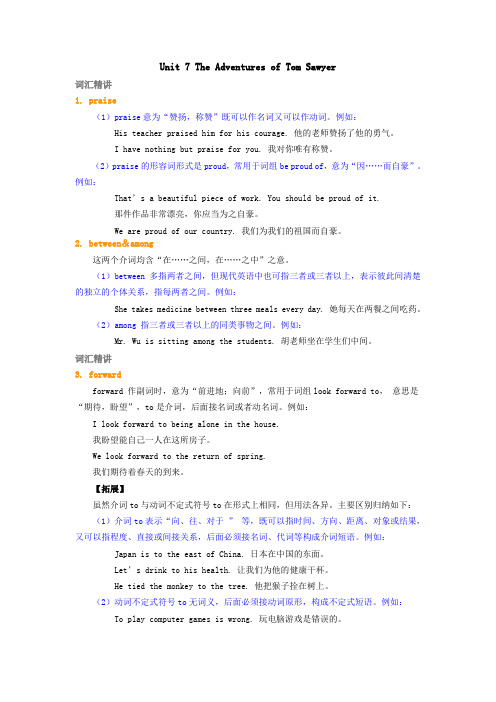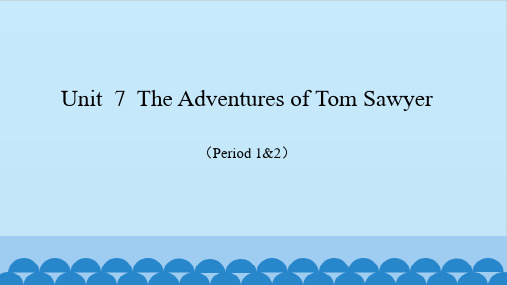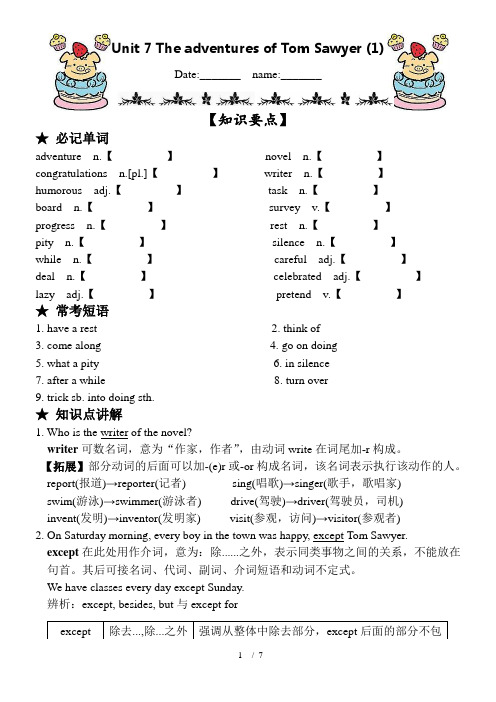Unit 7 The Adventures of Tom Sawyer
- 格式:doc
- 大小:136.00 KB
- 文档页数:17

Unit 7 The Adventures of Tom Sawyer词汇精讲1. praise(1)praise意为“赞扬,称赞”既可以作名词又可以作动词。
例如:His teacher praised him for his courage. 他的老师赞扬了他的勇气。
I have nothing but praise for you. 我对你唯有称赞。
(2)praise的形容词形式是proud,常用于词组be proud of,意为“因……而自豪”。
例如:That’s a beautiful piece of work. You should be proud of it.那件作品非常漂亮,你应当为之自豪。
We are proud of our country. 我们为我们的祖国而自豪。
2. between&among这两个介词均含“在……之间,在……之中”之意。
(1)between 多指两者之间,但现代英语中也可指三者或三者以上,表示彼此间清楚的独立的个体关系,指每两者之间。
例如:She takes medicine between three meals every day. 她每天在两餐之间吃药。
(2)among 指三者或三者以上的同类事物之间。
例如:Mr. Wu is sitting among the students. 胡老师坐在学生们中间。
词汇精讲3. forwardforward 作副词时,意为“前进地;向前”,常用于词组look forward to,意思是“期待,盼望”,to是介词,后面接名词或者动名词。
例如:I look forward to being alone in the house.我盼望能自己一人在这所房子。
We look forward to the return of spring.我们期待着春天的到来。
【拓展】虽然介词to与动词不定式符号to在形式上相同,但用法各异。

牛津深圳版英语九年级上册:Unit 7 《The Adventures of Tom Sawyer》教学设计3一. 教材分析《牛津深圳版英语九年级上册:Unit 7 The Adventures of Tom Sawyer》讲述了美国著名作家马克·吐温的经典作品《汤姆·索亚历险记》中的一个故事。
本节课将引导学生学习汤姆·索亚的勇敢和智慧,通过故事了解美国的文化背景,提高学生的英语阅读能力。
教材内容丰富,插图生动有趣,激发学生的学习兴趣。
二. 学情分析九年级的学生已经具备一定的英语阅读和写作能力,但对于美国文化背景的了解相对较少。
通过本节课的学习,学生将提高自己的阅读理解能力,拓展文化视野。
在教学过程中,教师应关注学生的个体差异,因材施教,充分调动学生的学习积极性。
三. 教学目标1.知识目标:–学生能够掌握故事中的主要人物、情节和背景。
–学生能够理解并运用故事中的重点词汇和句型。
2.能力目标:–学生能够提高阅读理解能力,快速捕捉文章大意。
–学生能够运用所学知识进行口语表达和写作。
3.情感目标:–学生能够培养对英语阅读的兴趣,乐于探索美国文化。
–学生能够学会欣赏勇敢、智慧、正义的品质,培养良好的道德观念。
四. 教学重难点•故事情节的理解和分析。
•重点词汇和句型的掌握。
•理解美国文化背景。
•运用所学知识进行口语表达和写作。
五. 教学方法1.任务型教学法:通过小组合作、讨论等方式,让学生在实践中掌握知识。
2.情境教学法:创设生动有趣的情境,激发学生的学习兴趣。
3.直接法:教师用目标语言进行授课,让学生直观地感受语言。
六. 教学准备1.教材和课件:准备教材和与课程相关的中英文课件。
2.教学资源:收集与故事相关的图片、视频等资源。
3.学生分组:将学生分成若干小组,便于开展任务型教学。
七. 教学过程1.导入(5分钟)–教师通过提问方式引导学生回顾上一节课的内容,激发学生的学习兴趣。

单元整体教学设计山洞遇险的故事,体现了汤姆说要顽皮大胆的性格特征。
五 Adventures of Huckleberry Finn记叙文(综合)Culture corner 版块介绍了马克·吐温的代表作,也是《汤姆·索亚历险记》的姐妹篇——《哈克贝利·费恩历险记》。
这部小说充分展示了美国当时的现实生活。
了解马克·吐温的更多作品及主人公。
表二:单元大观念小观念3:尝试了解马克•吐温的其他作品。
输出:以马克•吐温友人的身份,介绍马克吐温和他的作品。
主题大观念小观念1:了解汤姆•索亚历险记。
小观念2:尝试阅读英语故事及其他英语课外读物。
输出:复述汤姆•索亚的“圈套”。
根据情境小组编制对话。
输出:通过网络或书籍搜集马克•吐温的其他著作进行介绍。
书面介绍马克•吐温的著作。
输出:根据情境使用定语从句描述人事物。
讲述自己最喜欢的故事。
撰写一篇读书报告。
分角色扮演故事人物。
Reading: “汤姆漆栅栏”讲述了汤姆设计“圈套”,让伙伴们产生兴趣并用宝贝交换漆栅栏的机会,巧妙的完成任务并完成任务。
Culture corner:《哈克贝利费恩历险记》的简介。
Study skills:学习“蛛网图”和列提纲,两种方法结合撰写读书报Listening: 《卡拉韦拉斯县驰名的跳蛙》故事情节和人物; Speak up:讲述自己最喜欢的一则故事;Grammar:《汤姆索亚历险记》中故事“目睹坟场惨案”的梗概;Writing:撰写一篇读书报告; More practice:《汤姆和贝奇被困山洞》的故事。
单元大观念:了解英美经典文学,培养良好阅读习惯,提升文学素养。
核心素养的综合表现:学习完本单元的内容,学生能读懂节选自长篇小说《汤姆·索亚历险记》中的故事“汤姆·索亚刷栅栏”; 能听懂马克·吐温的短篇小说《卡拉韦拉斯县驰名的跳蛙》简写版故事情节的发展,理解主要人物和事件;能口头表达祝贺与同情;能掌握读书报告的结构,仿照范文,就自己最喜欢的一则故事写一篇读书报告。


Unit 7 The adventures of Tom Sawyer (1)Date:_______ name:_______【知识要点】★必记单词adventure n.【】novel n.【】congratulations n.[pl.]【】writer n.【】humorous adj.【】task n.【】board n.【】survey v.【】progress n.【】rest n.【】pity n.【】silence n.【】while n.【】careful adj.【】deal n.【】celebrated adj.【】lazy adj.【】pretend v.【】★常考短语1. have a rest2. think of3. come along4. go on doing5. what a pity6. in silence7. after a while 8. turn over9. trick sb. into doing sth.★知识点讲解1. Who is the writer of the novel?writer可数名词,意为“作家,作者”,由动词write在词尾加-r构成。
【拓展】部分动词的后面可以加-(e)r或-or构成名词,该名词表示执行该动作的人。
report(报道)→reporter(记者) sing(唱歌)→singer(歌手,歌唱家)swim(游泳)→swimmer(游泳者) drive(驾驶)→driver(驾驶员,司机)invent(发明)→inventor(发明家) visit(参观,访问)→visitor(参观者)2. On Saturday morning, every boy in the town was happy, except Tom Sawyer.except在此处用作介词,意为:除......之外,表示同类事物之间的关系,不能放在句首。

牛津深圳版英语九上Unit 7《The Adventures of Tom Sawyer》教学设计6一. 教材分析《The Adventures of Tom Sawyer》是牛津深圳版英语九上Unit 7的一篇阅读文章,讲述了汤姆·索亚的冒险故事。
本篇文章趣味性强,情节丰富,能够激发学生的学习兴趣。
通过阅读这篇文章,学生可以提高阅读理解能力,学习到更多关于冒险、勇气、友谊等主题的词汇和表达方式。
二. 学情分析九年级的学生已经具备了一定的英语基础,能够独立阅读中等难度的英语文章。
但学生在阅读过程中可能会遇到一些生词和短语,需要教师给予适当的引导和帮助。
此外,学生对于西方文化背景可能了解不多,需要在教学过程中进行补充。
三. 教学目标1.知识目标:–能够理解文章大意,把握主要情节。
–学习并掌握文章中出现的重点词汇和短语。
2.能力目标:–提高学生的阅读理解能力。
–培养学生的猜测词义、推理判断等阅读技巧。
3.情感目标:–培养学生对冒险、勇气、友谊等主题的思考。
–增强学生对英语学习的兴趣。
四. 教学重难点•文章主要情节的把握。
•重点词汇和短语的学习。
•理解并运用文章中的冒险、勇气、友谊等主题的词汇和表达方式。
•对于西方文化背景的了解。
五. 教学方法1.任务型教学法:通过设定各种任务,激发学生的学习兴趣,提高学生的参与度。
2.合作学习法:鼓励学生分组讨论,培养学生的团队合作能力。
3.启发式教学法:引导学生主动思考,培养学生的推理判断能力。
六. 教学准备1.教师准备:–熟悉教材,明确教学目标。
–准备相关教学资料,如PPT、词汇卡片等。
2.学生准备:–预习文章,初步了解文章内容。
–查阅的生词和短语。
七. 教学过程1.导入(5分钟)–教师通过提问方式引导学生回顾上节课的内容,为新课的学习做好铺垫。
2.呈现(10分钟)–教师通过PPT展示文章主要情节,引导学生关注重点词汇和短语。
3.操练(15分钟)–教师学生进行小组活动,讨论文章中的冒险、勇气、友谊等主题。
Module 4 A taste of literatureUnit 7 The Adventures of Tom Sawyer 教案Period 1I. Teaching Aims:1. Learn and master new words, phrases and sentence patterns.2. Enable the students to know about Mark Twain and his famous stories.3. Deve lop the students’ reading and listening ability.II. Teaching Main Points:1. Improve the students’ reading, listening ability.2. Master some phrases and sentence patterns.III. Teaching Difficult Points:1. To read and listen effectively.2. Phrases and sentence patterns.IV. Teaching Methods:1. Fast reading to find out the general information about the story from the novel “The Adventures of Tom Sawyer”.2. Question-and-answer activities to help the students to go through the whole passage.3. Individual, pair and group work to make every student work in class.V. Teaching Aids:The blackboard, computer, projector, audiotape, flashcards, picturesVI. Teaching Procedures:Step 1 GreetingStep 2 Revision and lead-inAsk some questions:1. Do you like reading?2. What kind of books do you like?3. Do you know anything about Mark Twain?4. Have you ever read the novel The Adventures of Tom Sawyer?Step 3 Presentation for readingAsk a question:Do you want to know more about Mark Twain and his master piece?Step 4 Fast reading1. Give 2 minutes to read passage quickly.2. Answer questions.3. Repeat the right answer and write them on the blackboard.Step 5 Careful reading1. Explain some main phrases and sentence patterns.2. Give 4 minutes to read passage carefully and do the exercises in pairs.3. Check the answer: Ask a team of students do it one by one.Step 6 Practice1. Summarize the main ideas of the passage.2. Divide students into groups to discuss the passage and other famous books and writers.3. Make a competition: List famous writers and their masterpiece as much as you can. Step 7 Consolidation and summary1. Emphasize the phrases and sentence patterns.2. Retell some information about the passage.Step 8Homework: Exercise book, review.Period 2I. Teaching Aims:1. Learn and master how to use relative clauses with “who”, “that” and “which”.2. Learn to express congratulations and sympathy.3. Learn to write a report on your favourite story.II. Teaching Main Points:1. Improve the students’ speaking, writing ability.2. Master some phrases, sentence patterns and grammar.III. Teaching Difficult Points:Phrases, sentence patterns and grammarIV. Teaching Methods:1. Question-and-answer activities to help the students to learn better.3. Individual, pair and group work to make every student work in class. V. Teaching Aids:The blackboard, computer, projector, audiotape, flashcards, pictures VI. Teaching Procedures:Step 1 GreetingStep 2 Revision and lead-in1. Free talk.2. Review the grammar they have learnt.3. Lead in the grammar we need to learn in this unit.Step 3 PresentationTell the students some usage of relative clauses with who, that and which. Step 6 Practice1. Summarize the main usage of the grammar.2. Divide students into groups to practice the grammar.Step 7 Consolidation and summary1. Emphasize the grammar.2. Ask some students to retell the usage of the grammar.Step 8Homework: Exercise book, review.。
牛津深圳版英语九上Unit 7《The Adventures of Tom Sawyer》教学设计2一. 教材分析《The Adventures of Tom Sawyer》是牛津深圳版英语九上Unit 7的一篇阅读材料,讲述了汤姆·索亚的冒险故事。
本课内容丰富,语言生动有趣,涉及到一些过去时态的语法知识。
通过本课的学习,学生可以提高阅读理解能力,学习到如何运用过去时态描述事件。
二. 学情分析九年级的学生已经具备了一定的英语基础,能够理解和运用一些基本的英语语法知识。
但是,对于较复杂的句子结构和较难的词汇,学生可能还需要进一步的帮助。
此外,学生可能对于西方文化和社会背景知识了解不多,因此在理解文章深层含义方面可能存在一定难度。
三. 教学目标1.能够理解课文内容,把握汤姆·索亚的冒险经历。
2.能够运用过去时态描述事件。
3.能够提高阅读理解能力,培养阅读兴趣。
4.能够了解西方文化和社会背景知识。
四. 教学重难点1.重点:理解课文内容,把握汤姆·索亚的冒险经历;运用过去时态描述事件。
2.难点:理解课文中的深层含义,掌握一些较复杂的句子结构和较难的词汇。
五. 教学方法1.任务型教学法:通过完成各种任务,激发学生的学习兴趣,提高学生的阅读理解能力。
2.情境教学法:创设情境,让学生在实际情境中运用英语,提高学生的语言运用能力。
3.合作学习法:引导学生分组讨论,培养学生的团队协作能力和沟通能力。
六. 教学准备1.教材:《The Adventures of Tom Sawyer》相关材料。
2.多媒体设备:电脑、投影仪等。
3.教学辅助材料:词汇卡片、图片等。
七. 教学过程1.导入(5分钟)利用多媒体展示一些与课文内容相关的图片,引导学生谈论图片中的场景,激发学生的学习兴趣。
同时,简要介绍《The Adventures of Tom Sawyer》的作者和背景知识。
2.呈现(10分钟)让学生阅读课文,注意理解课文内容,把握汤姆·索亚的冒险经历。
UNIT 7 The Adventures of Tom Sawyer 一、词汇短语学习(一)课内单词(二)重点短语NO. PHRASE CHINESE NOTE1 a report on…有关…的报告2 at that time在那时3 encourage sb. to do sth.鼓励某人做某事4 a novel called…(被)命名为…的小说5 a task of doing sth.一项做某事的任务6 30 yards long30码长7 have a rest休息一下8 begin to do sth.开始做某事9 think of想象到,想出10 make fun of sb.取消某人11 pick up捡起12 went back to work继续工作13 what a pity真可惜14 enjoy oneself玩得开心15 a chance to do sth.做某事的机会16 go on doing sth.不停地做,继续做某事17 in silence沉默地18 after a while过了一会19 let sb. do sth.让某人做某事20 warn sb. to do sth.警告某人做某事21 offer sb, sth.给某人提供某事22 three coats of paint三层油漆23 so…that…如此…以致…25 turn sth. Over使翻转26 trick sb. Into doing sth.诱使某人做某事(三)词汇练习题型1:单词拼写8.(1分)He usually arrives home late at night.However,he came home earlier than u last night.9.(1分)I often t myself to a cup of coffee in the afternoon.10.(1分)Don't worry.You will be given p of time to make a decision.11.(1分)Have you read the restaurant r?It says the food here is delicious.12.(1分)We should have a m examination at least once a year.13.(1分)According to this r,woman live between five and seven years longer than men.【答案】usual.【答案】treat.【答案】plenty.【答案】review.【答案】medical.【答案】research.题型2:完成句子14.(2分)这个班的学生大体上都很活跃.the students in the class are active.15.(2分)我很少吃油炸食物,因为它不利于健康.I seldom eat because it is bad for health.16.(2分)他已被医生告知要减肥并戒烟.He has been told to and stop smoking by the doctor.17.(2分)你愿意主持这次新年晚会吗?you the New Year Party?18.(2分)这家餐厅通常在早上七点到九点提供早餐.Breakfast usually from 7 a.m.to 9 a m in this restaurant.19.(2分)乔琳告诉我她昨天从美国回来了.Jolin told me from America yesterday.20.(2分)我想知道在哪里可以买到这场音乐会的票.I wonder the ticket of this concert.【答案】In general.【答案】fried food.【答案】lose weight【答案】Would like to host【答案】is;served【答案】that she came back【答案】where I can buy题型3:短文填空(5分)A poor young man went to Paris, expecting that his father’s friend could help him find a business for living."Are you 1. g_________ at maths ?” his father’s friend asked him. The young man 2. s__________his head. "How is your history? How about your law?”The young man lowered his head sadly.His father’s friend asked again and again, but the young man could only shake his head. He himself couldn't find out any advantages.“Then write down your address first.” The young man wrote his address and turned to leave, but he was stopped by his father’s friend. “Your name is written very beautifully, which is your advantage. You shouldn't satisfy yourself with finding a 3. j_________ for living.”Many years later, the young man wrote the classical works that were well-known in the world. He was Alexandre Dumas Pere (大仲马, a 4. f_________ French writer of the 18th century.There are many ordinary persons in the world who all have many small advantages, but they can’t find10. t__________. In fact, there is a gold mine in every ordinary life. If you’re willing to dig, you will dig out treasures that surprise yourself.【答案】1.good 2.shook 3.job 4. famous 5.themselves题型4:完成句子(14分,每小题2分)1.我们上当受骗买了一辆故障车。
Unit 7 The Adventures of Tom Sawyer词汇精讲1. praise(1)praise意为“赞扬,称赞”既可以作名词又可以作动词。
例如:His teacher praised him for his courage. 他的老师赞扬了他的勇气。
I have nothing but praise for you. 我对你唯有称赞。
(2)praise的形容词形式是proud,常用于词组be proud of,意为“因……而自豪”。
例如:That’s a beautiful piece of work. You should be proud of it.那件作品非常漂亮,你应当为之自豪。
We are proud of our country. 我们为我们的祖国而自豪。
2. between&among这两个介词均含“在……之间,在……之中”之意。
(1)between 多指两者之间,但现代英语中也可指三者或三者以上,表示彼此间清楚的独立的个体关系,指每两者之间。
例如:She takes medicine between three meals every day. 她每天在两餐之间吃药。
(2)among 指三者或三者以上的同类事物之间。
例如:Mr. Wu is sitting among the students. 胡老师坐在学生们中间。
词汇精讲3. forwardforward 作副词时,意为“前进地;向前”,常用于词组look forward to,意思是“期待,盼望”,to是介词,后面接名词或者动名词。
例如:I look forward to being alone in the house.我盼望能自己一人在这所房子。
We look forward to the return of spring.我们期待着春天的到来。
【拓展】虽然介词to与动词不定式符号to在形式上相同,但用法各异。
主要区别归纳如下:(1)介词to表示“向、往、对于”等,既可以指时间、方向、距离、对象或结果,又可以指程度、直接或间接关系,后面必须接名词、代词等构成介词短语。
例如: Japan is to the east of China. 日本在中国的东面。
Let’s drink to his health. 让我们为他的健康干杯。
He tied the monkey to the tree. 他把猴子拴在树上。
(2)动词不定式符号to无词义,后面必须接动词原形,构成不定式短语。
例如: To play computer games is wrong. 玩电脑游戏是错误的。
My job is to teach English.我的工作是教英语。
I wish to go there. 我希望去那儿。
4. beatbeat是及物动词,有以下用法:(1)意为“赢;打败;战胜”,后接人或某一团队、组织等,其过去式为beat。
例如:I beat him at long jump yesterday. 昨天跳远我赢了他。
(2)意为“打;击”,表示连续不断的打击。
例如:Who is beating the drum? 谁在打鼓?(3)表示“(心脏)等跳动”。
例如:I feel my heart is beating fast. 我觉得我的心脏在剧烈跳动。
【拓展】beat和win都有“赢”的意思,但用法不同:beat的宾语为人或相当于人的团体、组织;而win的宾语为比赛或某个项目,过去式为won。
例如:Though we were weak, we beat them. 虽然我们弱,但我们赢了他们。
Who win the first prize in the competition? 谁在比赛中赢得了一等奖?5. author&writerauthor名词,意为“作者,作家”,是指出版过书的作者,writer多指没有出版过书但是为报刊写过稿子的作者(撰稿人、抄写员、文书等)。
best author 指畅销书作者, film author指电影电视剧本作家,writer club指写作爱好者协会。
例如:Mark Twain is his favorite author. 马克•吐温是他最喜爱的作家。
Her mother is a good writer. 她妈妈是名很好的抄写员。
6. work, task&job(1)work 最普通用词,含义广,指人们日常生活和工作中所从事的有目的的体力或脑力劳动。
例如:I have to bring my work home today. 今天我得把工作带回家做。
(2)task 通常指分派给的任务,也指自愿的工作,但往往是艰巨或令人厌烦的工作。
例如:She had the difficult task of pulling out all the weeds.她的苦差事是拔除所有的杂草(3)job 多用于口语,侧重指受雇用的,以谋生为目的工作,不论有无技术,也不管是零工或散工。
例如:He did all kinds of odd jobs. 他做各种零活。
7. progressprogress是不可数名词,意为“进步,上进;发展”。
例如:make progress取得进步make progress with…在……方面取得进步Tom is making much progress at school now. Tom现在在学校进步很大。
8. rest(1)rest 作名词,意为“休息,剩余部分,支持物”,have a rest 意为“休息一下”,the rest of 意为“其余的……,剩下的……”。
例如:You are too tired. You’d better have a rest now. 你太累了。
你现在最好休息一下。
The rest of the book are my birthday presents. 剩下的书是我的生日礼物。
When you are sitting, keep your elbow on the arm rest. 坐立时,把胳膊肘靠在扶手上。
(2)rest 作动词,意为“使休息,使轻松”。
The bird rested itself on the branch. 那只鸟站在树枝上休息。
词汇精练I. 英汉互译。
1. look forward to ____________2. thousands of __________3. 放弃___________4. come along _________5. all the time _________6. sum up __________7. 看起来像_________ 8. 过了一会儿__________ 9. in the face of _________10. in silence ___________答案与解析1. 期待,期盼2. 数以千计的3. give up4. 出现5. 总是,一直6. 总结,概括7. look like8. after a while9. 面对10. 沉默地II. 根据所给汉语或首字母提示完成下列单词的拼写,使句意明确,语言通顺。
1.They sat there in s______.They didn’t talk with each other.2.He ______(查看、审视) the car from the outside and admired greatly.3.We have made some ______(进展) towards reaching an agreement.4.The ______(交易) will not be disadvantageous(不利的) to your company.5.We are tired.Let’s ______(休息).6.We are off ______(一会儿).7. Our team b________ theirs in the end.8.Mike's father looks happy because his son has made great ______(进步)this year.9. The a________ of this book is Mark Twain.10. You should read as many English books as p_______.答案与解析1.silence 2.surveyed 3.progress 4.deal 5.take/have a rest 6.for a while 7. beat 8.progress 9. author 10. possibleIII. 用方框中所给词或短语的适当形式填空。
1.I don’t get many chances _______(talk) to her recently.2.The students went on _______(talk) and laughing on the way.3.The teacher often warns us _______(study) harder.4.The boy tricked the girl into _______(do) the homework for him.5.Li Ming began to learn English by _______(him) three years ago.6. His mother loves him very much and is always _______ (praise) of him.答案与解析1.to talk 2.talking 3.to study 4.doing 5.himself 6. proudⅣ. 选词填空。
1. The teacher are sitting _________ (between,among) the students.2. Lily is sitting _______ (between, among)Mary and Ann.3. Our team ________ (won, beat) theirs last week.4. Our team _______ (won, beat) the game last week.5. What’s your mother’s ________ (work, job, task)?答案与解析1. among2. between3. beat4. won5. job句式精讲1. On Saturday morning, every boy in town was happy, except Tom Sawyer.except是“除……之外(不包括本身在内)”的意思,含有否定和排除的意思,表示除去一部分,着重在“不包括”(not including)的含义。